by Winding Pathways | Sep 8, 2022 | (Sub)Urban Homesteading, Birds, Nature
Sometimes an animal’s name is misleading. Take the common nighthawks. It’s not a hawk and it doesn’t only fly at night. We often sit evenings on our back deck at Winding Pathways. In late summer 2022, we have been treated as dozens of aerial dancers – nighthawks – wheel overhead stalking mosquitoes and other insects. They can have all they can catch!
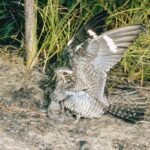
Common Nighthawks blend in with the ground. courtesy Free Photos
These birds are wonders. Closely related to whip-poor-wills, the brown feathers of the common nighthawk render them nearly invisible when resting in dry leaves or gravel during the day. They love evenings and wing overhead with their massive mouths open to snare tasty insects from the air.
Sometimes they pass just a few feet overhead. Occasionally they’re so high up that they are just fast-moving-turning-on-a-dime specks. Always they show distinct white stripes on the underside of their pointed wings.
Habits of Nighthawks
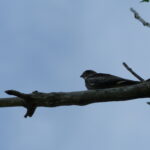
Resting nighthawk
We watched dozens of them in September 2022 and know that like many other migratory birds, they’ll join other birds for winter quarters in South America, so we enjoy them when we can. Daily we track bird migrations on the birdcast.info site. Nighthawks are one of the most widespread of North American birds, visible over farms, forests, and cities. Sometimes they even nest on gravel surfaced roofs of commercial buildings downtown and gravel areas of yards. We’ve caught glimpses of them resting on tree limbs. Watch the video to see many characteristics of nighthawks – their flight, sounds (listen for the “boom” of their wings), resting habits like sinking into the ground and yawning, and toward the end of this mini-documentary -the “waddle.” Fun!
Unfortunately, nighthawks have been declining about 1% a year since the 1960s. Why??? Pesticides, perhaps, reduce the insects that nighthawks feed on, and the loss of habitat. We don’t know for sure, but we enjoy watching their evening sky dance and hope people help them reverse their decline to continue their sky dance over much of the continent gobbling up insects.
by Winding Pathways | Jul 28, 2022 | (Sub)Urban Homesteading, Birds, Nature
Views From the Recliner
Guest Blogger, Susan Fellows
My first-floor, corner apartment sits on the edge of a large green space and parking lot surrounded by a stand of pines, maples, and oaks. On one side is a complex of boutique stores, restaurants, and apartments/condos. Nearby and opposite the greenspace is a residents’ home for memory care. Last year I had placed outside my living room window a double shepherd’s crook feeder visible from my recliner. I am older and have some medical issues that restrict movement. So, a good view of the outside and the birds is important to me. They are entertaining! That first year I had what seemed like a million new sparrows that went through the wild bird seed like crazy. This year, I haven’t seen as many newly fledged sparrows.
Attracting a Variety of Birds
This year I put out several feeders on the double shepherd’s crook – one for black oil sunflowers and another for wild bird seed. Also on that post, I have a “cage” of suet and a sock of blick niger thistle seed. A couple of months ago I added a single shepherd’s crook with a mealy worm feeder. This spring and early summer I have seen pairs of the house and purple finches, house and chipping sparrows, several pairs of goldfinches, and at least one pair of bluebirds. They come to the sunflower and thistle seed, which the goldfinches seem to prefer. About a week ago, a mockingbird started coming and feeds entirely on the suet. Recently I put out wild bird food which hangs from the other hook on the double shepherd’s crook. I had put out mealy worms that I prefer the bluebirds have, but the house and chipping sparrows decided they own it. Flying over and calling from the grassy area are killdeer. With their shrill call, they are easy to spot as they hobble away with their fake broken wing act to lure predators from their ground nest. They nest in low vegetation, like the nearby grassy lawn.
-
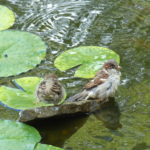
-
A water source helps attract birds.
-
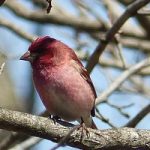
-
Some birds homestead at Winding Pathways.
-
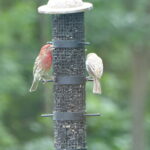
-
The house finches eat serenely.
Fledging Bluebird

Male Bluebird
The memory home nearby has a bluebird nesting box on the quiet side of the building. I believe that is where the bluebirds come from.to feed. Several days ago I heard quite a racket from the feeding station. Looking outside, I spotted a fairly large bird with a highly streaked white breast, perched on the top of the single shepherd’s crook. An adult bluebird was also on the feeder. The bird making the racket had its beak open waiting for the adult to feed it. It didn’t. It was time for the baby to learn to eat on its own. At that point, I could see bright blue in its tail feathers. I was so excited! It was a baby bluebird!
Another day, I was looking out my window when suddenly a little, male chipping sparrow with his chestnut top on his head arrived bringing with him a smaller bird that landed close to him, beak open. Dad bird fed baby bird several pieces of seed and then showed baby bird how to do it, but as I watched baby still hadn’t got the hang of it.
Invasion by New Comers to the Feeder
A newcomer at the mealy worm feeder appeared recently – starlings. I was invaded by baby starlings. At least 15 had taken over the feeders. To lure them away from the hanging feeders, I put out a seed block on the ground at the base of the other feeders. Although I can’t see it, I expect the starlings may be happier at it than just eating crumbs from the open mealy worm feeder. I hope they will leave soon. They eat everything.
I have enjoyed sharing all these spring bird-related events with Winding Pathways. I expect to be inundated with newly fledged sparrows any time soon. Enjoy your birding adventures as I have enjoyed what I can see from my recliner.
by Winding Pathways | Sep 2, 2021 | (Sub)Urban Homesteading, Birds, Nature
A flurry of movement caught our attention. Just outside the dining room window, a tiny scrap of a bird flitted around. It wasn’t a wren, goldfinch, or sparrow. They’re around all year. Just what was it?
For most birders, May is the month to live for. Orioles, grosbeaks, tanagers, and warblers arrive as if by magic. They’re colorful, sing with gusto, and are easy to spot. It’s an exciting time, but it’s not THE ONLY exciting time.
All the colorful migrating May birds en route to northern nesting sites and the ones that stick around to nest locally are now heading south to avoid winter’s harshness. September is an outstanding birding month, but it’s also challenging.
September Birding
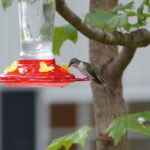
Birds stock up on high-calorie foods before their long migrations.
The birds are there but easy to miss. Many have gone through a late summer molt. They’ve replaced gaudy spring feathers with drab ones that enable them to hide better. September is a business month for birds. In May they happily court mates, but four months later the priority is beefing up their bodies for the long flight south. They dart about, often out of sight, seeking tasty insects, spiders, and seeds to fuel migration.
September birding takes patience. We find the most effective way to see birds is to sit quietly and watch. While we may slowly walk trails spotting birds in May, by September we sit on our deck in comfortable chairs, binoculars handy, and bird books and apps at the ready. We don’t find the birds. They find us, but because they don’t sing much and often look different than in Spring, identification is challenging.
Our backyard birding is exciting because we’ve diversified vegetation and have brushy areas, a prairie, a small pond, and big trees close by. However, we don’t just look there for birds. Sometimes we look upward to see soaring nighthawks, migrating raptors, and an occasional skein of Canada geese.
-
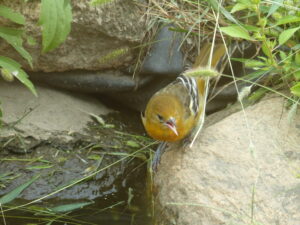
-
Birds stop for a drink and to fill up on the berries nearby.
-
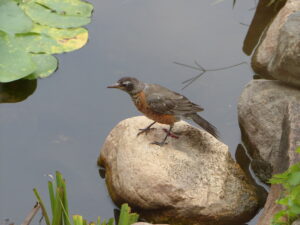
-
Keeping a wary eye, the robin cautiously gets a drink.
Identifying Fall Birds
To help with identification we use several printed bird books including the Peterson Guide and David Allen Sibley’s books. Increasingly we rely on Merlin. It’s an outstanding app produced by the Cornell University Laboratory of Ornithology. Even better, it’s free. The app easily helps identify species and shows many photos of every bird in spring/fall/juvenile/gender plumages. It also has range maps and recordings of the birds’ calls and songs. Merlin recently added a new function: sound identification. Point the phone at a singing bird and the app will help identify it by sound.
After we tentatively identify a bird, we try to confirm it by an Internet search and by consulting our birding friends. Our definitive online source is the Lab of Ornithology’s website. The site contains a vast amount of information, including how to access and use Merlin and eBird.
Easy to Keep Records
eBird allows us to record all bird species we spot in a day. Then we email results to the Lab for analysis. It’s great fun and helps the Lab research bird populations and movement.
There’s more to fall than football and leaf raking. It’s an excellent time to bird and the best birding is often the backyard.
by Winding Pathways | Mar 11, 2021 | (Sub)Urban Homesteading, Birds, Pests
Millions of people love their cats. Some 36% of households keep an average of two cats. They are the second most popular companion animal in the United States, lagging only behind dogs.
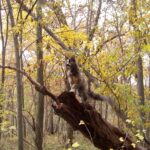
Cats decimate bird populations.
Some cats cause problems, especially when owners allow them to free-range the neighborhood. According to the American Bird Conservancy, they kill 2.4 billion birds a year and may be a significant cause of the decline of many species.
Catios to the rescue!
A growing number of cat lovers, many who also enjoy bird watching, recognize the problem and are increasingly adding a catio to their home. Wonder what it is???? It’s simply an enclosure that allows the family cats to enjoy fresh air, sunshine, and a bit of adventure without allowing them complete access to the neighborhood.
Many catios are enclosed patios, which spawned the name, that let cats play outdoors while their owners enjoy lounging or socializing nearby. They are relaxing places for both species. Other catios are small and positioned outside windows. Catios can be either purchased or homemade and often an existing patio can be modified into one.
Safety First!
Although cats love roaming the neighborhood, it is not a safe place. They pick up ticks and transfer them to humans, suffer accidents, are killed by cars as they cross streets, and are taken by predators.
A catio is a good solution to several problems. It allows cats to enjoy the outdoors safe from cars and predators in a place where they can’t kill birds. And, the owners always know where their cat is.
Harmony
An array of catio photos is visible on Catio Spaces. Many other websites feature them. Catios are a great way for cat lovers to show care of wildlife species, keep their cats safe, and live in peace with human neighbors who are frustrated when they spot a feline stalking birds under their feeder.
by Winding Pathways | Jul 9, 2020 | (Sub)Urban Homesteading, Garden/Yard
One morning while watching the arrival of spring migrant birds, we were startled and annoyed to see a cat lurking under the feeder seeking a bird victim. We so enjoy the Summer and Scarlet Tanagers, and Indigo Buntings at our feeders. They add diversity to our usual visitors – titmice, chickadees, cardinals, and woodpeckers who visit throughout the year.
We chased the cat away but began researching the history of domestic cats and their impact on wildlife. It’s both fascinating and concerning.
Challenges Facing Birds
Modern birds face many challenges, including habitat destruction, climate change, light pollution that disrupts navigation, and crashing into towers. However, the International Union for Conservation of Nature lists domestic cats as one of the world’s worst nonnative invasive species. They are the number one human-caused threat to birds in the United States and Canada and kill upwards of 2.4 billion a year.
Domestication of Cats
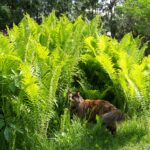
Cats have a strong hunting instinct.
People and cats have a long relationship. They were domesticated from the European wildcat over 10,000 years ago, probably in the Fertile Crescent. Wherever people have migrated to they’ve brought along cats. Even after so many years living with people this animal, Felis sylvestris, retains its predatory instincts, reproduces rapidly, and readily goes wild, or feral.
Domestic cats are fascinating animals loved by millions of people, so any criticism of them often brings a sharp emotional response. However, there’s no doubt they harm wildlife, and one of the main reasons is their artificial high population density.
Animal Territories
Wild predators, like cougars, bobcats, and wolves have vast territories. It takes plenty of land to sustainably produce enough prey for a predator to live. So, if they are crowded together they’d starve. A naturally occurring population of predators in a healthy ecosystem simply has few individuals. For example, a healthy population of native bobcats may have only a few individuals spread over several square miles. The same goes for wild native European wildcats in natural areas in Asia and Europe. The problem comes when humans crowd many cats into a small area.
Families that don’t want cats stalking birds can take a few actions to reduce the death toll of birds. These include:
- Asking neighbors to keep their animals in their home or yard.
- Placing feeders on metal “shepherd’s hooks” that cats can’t climb.
- Configuring a ring of wire mesh around feeding stations to exclude cats from catching juncos, chipping sparrows, and other ground-feeding birds.
Birds face many hazards in this modern world. Cat predation is one that can be reduced. Both cats and birds can enjoy a safer life if the owners of descendants of the European wildcat kept their pets indoors.











